Efficacy and Role of Double Spinned Platelet Rich Plasma Therapy in Elderly with Rotator Cuff Tear of Shoulder
Dr. Kalyan Kumar1, Dr. Hari Krishna Koya1, Dr. Aditya Ch RSS2, Dr. Satya Kumar K3,*
1Assistant Professor of Orthopaedics, NRI Academy of Sciences, Chinakakani, Andhra Pradesh, India
2Junior Resident of Orthopaedics, NRI Academy of Sciences, Chinakakani, Andhra Pradesh, India
3Professor and Hod Orthopaedics, NRI Academy of Sciences, Chinakakani, Andhra Pradesh, India
*Corresponding Author: Dr. Satya Kumar K, Ms (Ortho), Professor and Hod Orthopaedics, NRI Academy of Sciences, Chinakakani, Andhra Pradesh, India
Received: 08 December 2020; Accepted: 14 December 2020; Published: 21 December 2020
Article Information
Citation: Dr. Kalyan Kumar, Dr. Hari Krishna Koya, Dr. Aditya Ch RSS, Dr. Satya Kumar K. Efficacy and Role of Double Spinned Platelet Rich Plasma Therapy in Elderly with Rotator Cuff Tear of Shoulder. Journal of Orthopaedics and Sports Medicine 2 (2020): 183-196.
View / Download Pdf Share at FacebookAbstract
Aim: To assess the efficacy of local injection of autologous P.R.P. into the shoulder joint on pain and function of patients with rotator cuff tears.
Objectives: To evaluate and analyze the results of local injection of platelet rich plasma in elderly with rotator cuff tear; To follow up the patients who had undergone the procedure and note the functional outcome and complications pertaining to the procedure.
Keywords
PRP; Platelet Rich Plasma; Rotator cuff tears
Orthopaedics articles Orthopaedics Research articles Orthopaedics review articles Orthopaedics PubMed articles Orthopaedics PubMed Central articles Orthopaedics 2023 articles Orthopaedics 2024 articles Orthopaedics Scopus articles Orthopaedics impact factor journals Orthopaedics Scopus journals Orthopaedics PubMed journals Orthopaedics medical journals Orthopaedics free journals Orthopaedics best journals Orthopaedics top journals Orthopaedics free medical journals Orthopaedics famous journals Orthopaedics Google Scholar indexed journals Rotator cuff tears articles Rotator cuff tears Research articles Rotator cuff tears review articles Rotator cuff tears PubMed articles Rotator cuff tears PubMed Central articles Rotator cuff tears 2023 articles Rotator cuff tears 2024 articles Rotator cuff tears Scopus articles Rotator cuff tears impact factor journals Rotator cuff tears Scopus journals Rotator cuff tears PubMed journals Rotator cuff tears medical journals Rotator cuff tears free journals Rotator cuff tears best journals Rotator cuff tears top journals Rotator cuff tears free medical journals Rotator cuff tears famous journals Rotator cuff tears Google Scholar indexed journals Tennis articles Tennis Research articles Tennis review articles Tennis PubMed articles Tennis PubMed Central articles Tennis 2023 articles Tennis 2024 articles Tennis Scopus articles Tennis impact factor journals Tennis Scopus journals Tennis PubMed journals Tennis medical journals Tennis free journals Tennis best journals Tennis top journals Tennis free medical journals Tennis famous journals Tennis Google Scholar indexed journals Baseball articles Baseball Research articles Baseball review articles Baseball PubMed articles Baseball PubMed Central articles Baseball 2023 articles Baseball 2024 articles Baseball Scopus articles Baseball impact factor journals Baseball Scopus journals Baseball PubMed journals Baseball medical journals Baseball free journals Baseball best journals Baseball top journals Baseball free medical journals Baseball famous journals Baseball Google Scholar indexed journals Swimming articles Swimming Research articles Swimming review articles Swimming PubMed articles Swimming PubMed Central articles Swimming 2023 articles Swimming 2024 articles Swimming Scopus articles Swimming impact factor journals Swimming Scopus journals Swimming PubMed journals Swimming medical journals Swimming free journals Swimming best journals Swimming top journals Swimming free medical journals Swimming famous journals Swimming Google Scholar indexed journals Traumatic injuries articles Traumatic injuries Research articles Traumatic injuries review articles Traumatic injuries PubMed articles Traumatic injuries PubMed Central articles Traumatic injuries 2023 articles Traumatic injuries 2024 articles Traumatic injuries Scopus articles Traumatic injuries impact factor journals Traumatic injuries Scopus journals Traumatic injuries PubMed journals Traumatic injuries medical journals Traumatic injuries free journals Traumatic injuries best journals Traumatic injuries top journals Traumatic injuries free medical journals Traumatic injuries famous journals Traumatic injuries Google Scholar indexed journals Physical therapy articles Physical therapy Research articles Physical therapy review articles Physical therapy PubMed articles Physical therapy PubMed Central articles Physical therapy 2023 articles Physical therapy 2024 articles Physical therapy Scopus articles Physical therapy impact factor journals Physical therapy Scopus journals Physical therapy PubMed journals Physical therapy medical journals Physical therapy free journals Physical therapy best journals Physical therapy top journals Physical therapy free medical journals Physical therapy famous journals Physical therapy Google Scholar indexed journals Chronic tendinopathy articles Chronic tendinopathy Research articles Chronic tendinopathy review articles Chronic tendinopathy PubMed articles Chronic tendinopathy PubMed Central articles Chronic tendinopathy 2023 articles Chronic tendinopathy 2024 articles Chronic tendinopathy Scopus articles Chronic tendinopathy impact factor journals Chronic tendinopathy Scopus journals Chronic tendinopathy PubMed journals Chronic tendinopathy medical journals Chronic tendinopathy free journals Chronic tendinopathy best journals Chronic tendinopathy top journals Chronic tendinopathy free medical journals Chronic tendinopathy famous journals Chronic tendinopathy Google Scholar indexed journals Hypothyroidism articles Hypothyroidism Research articles Hypothyroidism review articles Hypothyroidism PubMed articles Hypothyroidism PubMed Central articles Hypothyroidism 2023 articles Hypothyroidism 2024 articles Hypothyroidism Scopus articles Hypothyroidism impact factor journals Hypothyroidism Scopus journals Hypothyroidism PubMed journals Hypothyroidism medical journals Hypothyroidism free journals Hypothyroidism best journals Hypothyroidism top journals Hypothyroidism free medical journals Hypothyroidism famous journals Hypothyroidism Google Scholar indexed journals Platelet-rich plasma articles Platelet-rich plasma Research articles Platelet-rich plasma review articles Platelet-rich plasma PubMed articles Platelet-rich plasma PubMed Central articles Platelet-rich plasma 2023 articles Platelet-rich plasma 2024 articles Platelet-rich plasma Scopus articles Platelet-rich plasma impact factor journals Platelet-rich plasma Scopus journals Platelet-rich plasma PubMed journals Platelet-rich plasma medical journals Platelet-rich plasma free journals Platelet-rich plasma best journals Platelet-rich plasma top journals Platelet-rich plasma free medical journals Platelet-rich plasma famous journals Platelet-rich plasma Google Scholar indexed journals Carpal tunnel syndrome articles Carpal tunnel syndrome Research articles Carpal tunnel syndrome review articles Carpal tunnel syndrome PubMed articles Carpal tunnel syndrome PubMed Central articles Carpal tunnel syndrome 2023 articles Carpal tunnel syndrome 2024 articles Carpal tunnel syndrome Scopus articles Carpal tunnel syndrome impact factor journals Carpal tunnel syndrome Scopus journals Carpal tunnel syndrome PubMed journals Carpal tunnel syndrome medical journals Carpal tunnel syndrome free journals Carpal tunnel syndrome best journals Carpal tunnel syndrome top journals Carpal tunnel syndrome free medical journals Carpal tunnel syndrome famous journals Carpal tunnel syndrome Google Scholar indexed journals Ucla score articles Ucla score Research articles Ucla score review articles Ucla score PubMed articles Ucla score PubMed Central articles Ucla score 2023 articles Ucla score 2024 articles Ucla score Scopus articles Ucla score impact factor journals Ucla score Scopus journals Ucla score PubMed journals Ucla score medical journals Ucla score free journals Ucla score best journals Ucla score top journals Ucla score free medical journals Ucla score famous journals Ucla score Google Scholar indexed journals Prp injection articles Prp injection Research articles Prp injection review articles Prp injection PubMed articles Prp injection PubMed Central articles Prp injection 2023 articles Prp injection 2024 articles Prp injection Scopus articles Prp injection impact factor journals Prp injection Scopus journals Prp injection PubMed journals Prp injection medical journals Prp injection free journals Prp injection best journals Prp injection top journals Prp injection free medical journals Prp injection famous journals Prp injection Google Scholar indexed journals Cervical neuropathy articles Cervical neuropathy Research articles Cervical neuropathy review articles Cervical neuropathy PubMed articles Cervical neuropathy PubMed Central articles Cervical neuropathy 2023 articles Cervical neuropathy 2024 articles Cervical neuropathy Scopus articles Cervical neuropathy impact factor journals Cervical neuropathy Scopus journals Cervical neuropathy PubMed journals Cervical neuropathy medical journals Cervical neuropathy free journals Cervical neuropathy best journals Cervical neuropathy top journals Cervical neuropathy free medical journals Cervical neuropathy famous journals Cervical neuropathy Google Scholar indexed journals Vas pain score articles Vas pain score Research articles Vas pain score review articles Vas pain score PubMed articles Vas pain score PubMed Central articles Vas pain score 2023 articles Vas pain score 2024 articles Vas pain score Scopus articles Vas pain score impact factor journals Vas pain score Scopus journals Vas pain score PubMed journals Vas pain score medical journals Vas pain score free journals Vas pain score best journals Vas pain score top journals Vas pain score free medical journals Vas pain score famous journals Vas pain score Google Scholar indexed journals
Article Details
1. Introduction
Rotator Cuff Tears (R.C.T.S) are a common injury among diverse patients, with the prevalence of injury increasing linearly with age [1]. It is a condition typically characterized by weakness and pain in the shoulder that is aggravated by overuse, applied weight, raising/lowering or rotating the involved arm, and overhead physical activities such as tennis, baseball, and swimming [2]. The supraspinatus muscle and tendon are the most common injury sites and can be damaged by traumatic injuries and degenerative changes [3]. Data obtained from cadaveric studies suggest that as many as 65% of individuals over the age of 70 years have a partial-thickness rotator cuff tear [4]. Often, rotator cuff tears are asymptomatic, making a diagnosis and early treatment challenging [5, 1]. The decision to pursue operative versus non-operative management is, therefore, often controversial. Surgical management may provide more immediate pain relief and functional improvement, but it signifies a higher risk of morbidity than non-surgical measures, particularly with an older population of patients [6]. Moreover, surgical repair is often followed by a lengthy recovery period and has variable outcomes. Current conservative treatments of partial rotator cuff tears include activity modification, oral medication, corticosteroid injection, and two targeted physical therapy [7]. Improperly managed partial rotator cuff tears can progress to debilitating full-thickness tears if left untreated [6]. This review seeks to assess an innovative, biological approach to treating R.C.T.s using autologous platelet-rich plasma (P.R.P.), intending to distill a safe and readily available, long-lasting treatment option that can be offered to a wide range of patients. Platelet-rich plasma for the conservative management of degenerative and acutely injured tissues is gaining recognition and popularity in the international community of clinician-scientists. A broad retrospective review on the use of ultrasound- guided P.R.P. injections for chronic tendinopathy in various bodily regions reported an 82% improvement in symptoms across all surveyed patients [6]. Furthermore, experiential clinical data suggests that P.R.P. is often an effective treatment for partial rotator cuff tears. Still, supportive data from published literature remains limited and is of variable quality and consistency. This paper will provide relevant background information on the anatomical function of the shoulder complex, with an emphasis on the rotator cuff and its pathophysiology. Next, explore some of the most currently utilized therapeutic interventions. The use of P.R.P. as an innovative biologic augmentation of rotator cuff repair will then be introduced, and various proposed studies involving the use of P.R.P. as an alternative treatment option will be discussed, leading to an analysis of patient outcomes and a critique of each study’s value. By evaluating the therapeutic value of P.R.P., this review can three potentially validate an additional nonsurgical alternative for the treatment of partial R.C.T.s and contribute to identifying specific subgroups of patients and pathologies that would gain the great benefit from its use in future studies.
2. Methodology
The main objective of our study was to compare the functional outcome in patients who were treated with platelet rich plasma for rotator cuff tear for this study purpose we have employed
- U C L A (University of California Los Angeles) shoulder scoring
- Vas Pain Score for evaluating the functional outcome.
2.1 Inclusion criteria
- Men and women between 50 to 80 year
- Primary, traumatic or degenerative rotator cuff tears of less than 15% thickness within 18 months of initial diagnosis
- Patients who gives consent.
2.2 Exclusion criteria
- Rotator cuff tears secondary to fracture and dislocations.
- Patients with an associated dislocation at the time of study.
- Rotator cuff tears that underwent prior surgical repair or revision arthroscopy.
- Preexisting conditions associated with upper extremity pain, including arthritis ,ongoing infection, carpal tunnel syndrome, cervical neuropathy or other nerve pathology, local malignancy, and systemic disorders(hypothyroidism, uncontrolled diabetes)
- Gross shoulder instability.
- Active infection.
- Pregnant or planned to become pregnant in next 12 months.
- Platelet count less than 180,000.
- Problems with follow up.
Autologous platelet rich plasma [7] was prepared in the N.R.I. Medical College Department of Orthopedics.
2.3 Procedure
Step 1: Take two 20 ml syringe with each 3 ml Acda and 17 ml venous blood (overall 34 ml blood)
Step 2: Remove needles, cover the tip of barrels with insulin caps
Step 3: Cut the edges of the syringe (cut the plunger and overhangs of the barrel)
Step 4: Place it in centrifuge with a pre-set spin of 1500 rpm for 15 mins. Place two syringes in the opposite direction in the centrifuge
Step 5: Start the procedure
Step 6: Aspirate plasma and buffy coat through three-way stopcock into another syringe. As a result, 20 ml will be collected
Step 7: Take another 20 ml of normal saline as a counterweight
Step 8: Place two syringes in opposite directions in the centrifuge
Step 9: Set the spin for 3500 rpm for 7 mins
Step 10: Discard plasma except for 1-2 ml
Step 11: Collect buffy coat with 1-2 ml of plasma.
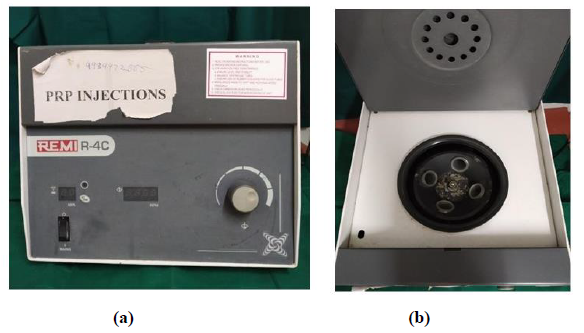
Figure 1: (a) Centrifuge machine; (b) Centrifuge rotor at center.
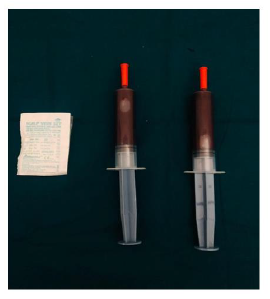
3ml ACDA+17 ml blood in each syringe;
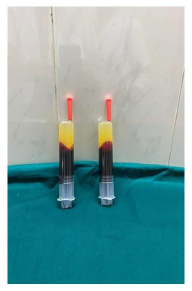
After first spin 1500 RPM for 15 minutes in centrifuge.
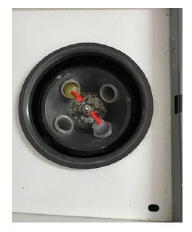
Second spin 3500 RPM for 7 minutes.
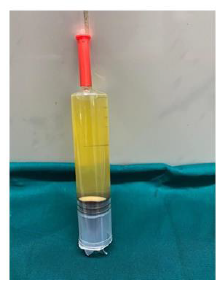
After second spin-remove platelet poor plasma leaving 3- 4 ml at the bottom.
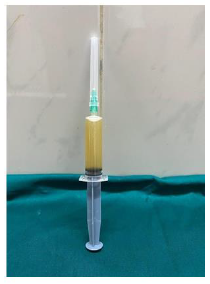
Reconstituted 3-4 ml platelet- rich plasma.
The process of separating platelet rich plasma was done under strict aseptic conditions. The patient’s baseline platelet count and leukocyte count were noted, and platelet rich plasma was calculated as having eight to ten times the baseline valve of platelets. The platelets concentration in the final product was corroborated by the department of the pathology, N.R.I. medical college on a periodic basis. We in this study did not use a leucocyte filter, and the final platelet rich plasma contained minute traces of leucocytes.
2.4 Injection protocol
The injection procedure was performed in the emergency operation theatre. The patient was placed supine on the operation table. Parts scrubbed, painted, and draped. Under sterile aseptic precautions, 3ml of platelet rich plasma was administered into the pathological site. The patient has advised analgesics and ice fomentation for pain after the procedure. The patients were advised to carry on with their regular work from day 1.
2.5 Outcome analysis
The patients were advised to follow up at 6 weeks, 3 months, and 6 months and 12 months .outcome analysis was done for the reduction in pain, decrease in stiffness, and improvement in physical function using the ucla score and vas pain score. The patients were also assessed for reduction in pain using visual analog scale both at pre-injection and at 3weeks, 6weeks, 3months and 6 months post-injection.
2.6 Follow up
Patient functional assessment was done based on pain relief, ability to carry on activities of daily living, strength.
3. Results
The Results were finally evaluated using shoulder scoring system.
- UCLA (University of California Los Angeles).
- Vas Pain Score (Visual Analog Score).
We studied 40 patients with rotator cuff tear who were treated with platelet rich plasma therapy.
|
Age in years |
Number of patients |
% |
|
51-60 |
18 |
45 |
|
61-70 |
17 |
42.5 |
|
>70 |
5 |
12.5 |
|
Total |
40 |
100.0 |
Mean ± Sd: 61.65 ± 6.5021
Table 1: Age distribution of patients studied.
|
Gender |
Number of patients |
% |
|
Male |
26 |
65 |
|
Female |
14 |
35 |
|
Total |
40 |
100 |
In our study maximum number of patients were male.
Table 2: Gender distribution of patients studied.
|
Type of tear |
Number of patients |
% |
|
Full thickness |
18 |
45 |
|
Partial |
22 |
55 |
|
Total |
40 |
100.0 |
Major part of our study contained partial thickness tears rather than full thickness tears.
Table 3: Distribution of type of tear of patients studied.
|
Etiology |
Number of patients |
% |
|
Degenerative |
32 |
80 |
|
Trauma |
8 |
20 |
|
Total |
40 |
100.0 |
Most common cause noted in our study for rotator cuff tears is degenerative.
Table 4: Distribution of etiology of patients studied.
|
Habits |
Number of patients (N=40) |
% |
|
Smoking |
||
|
· No |
38 |
95 |
|
· Yes |
2 |
5 |
|
Alcohol |
||
|
· No |
36 |
90 |
|
· Yes |
4 |
10 |
The incidence of smoking and alcohol is as shown and is of not much significance.
Table 5: Distribution of habits of patients studied.
|
Symptom |
Number of patients |
% |
|
Inability to lift shoulder |
27 |
67.5 |
|
Pain in shoulder |
13 |
32.5 |
|
Total |
40 |
100.0 |
Majority of patients complain of inability to lift affected shoulder.
Table 6: Distribution of symptom of patients studied.
|
Jobes empty can |
Number of patients |
% |
|
Negative |
0 |
0.0 |
|
Positive |
40 |
100.0 |
|
Total |
40 |
100.0 |
Jobes empty can test is positive in all the cases.
Table7: Distribution of jobes empty can of patients studied.
|
Restriction of extrotation |
Number of patients |
% |
|
Negative |
8 |
20 |
|
Positive |
32 |
80 |
|
Total |
40 |
100.0 |
Restriction of external rotation seen in 32 patients.
Table 8: Distribution of restriction of external rotation of patients studied.
|
Arm lift off |
Number of patients |
% |
|
Negative |
36 |
90 |
|
Positive |
4 |
10 |
|
Total |
40 |
100.0 |
Arm lift off was negative in 89.35% patient.
Table 9: Restriction of external rotation seen in 32 patients.
|
Belly press test |
Number of patients |
% |
|
Negative |
25 |
62.5 |
|
Positive |
15 |
37.5 |
|
Total |
40 |
100.0 |
Belly press was negative in 62.5 % patients.
Table 10: Distribution of belly press test studied.
|
Speed test |
Number of patients |
% |
|
Negative |
40 |
100.0 |
|
Positive |
0 |
0.0 |
|
Total |
40 |
100.0 |
Table 11: Distribution of speed test of patients studied.
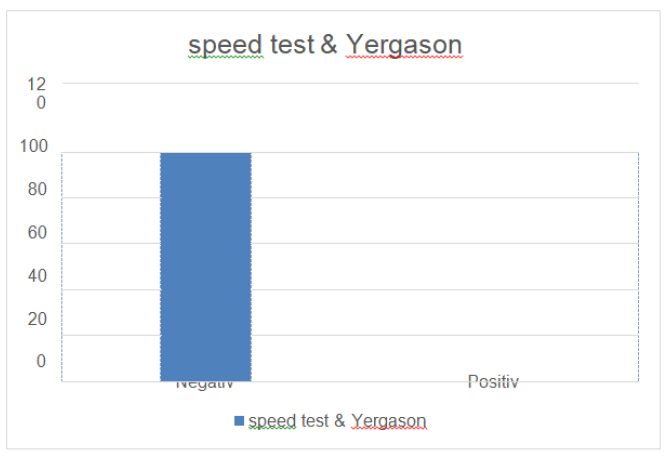
|
Neer and Hawkin test |
Number of patients |
% |
|
Negative |
28 |
70 |
|
Positive |
12 |
30 |
|
Total |
40 |
100.0 |
Table 12: Distribution of Neer and Hawkin test of patients studied.
|
Ucla |
||||||
|
At presentation |
At 3 Wks |
At 6 Wks |
At 12 Wks |
At 6 Months |
At 1 Year |
|
|
Min-max |
6.00-19.00 |
8.00-17.00 |
8.00-18.00 |
14.00-29.00 |
17.00-32.00 |
30.00-35.00 |
|
Mean ±sd |
10.325±3.50 |
12.075±2.21 |
15.525±2.25 |
19.9±3.814 |
27.32±3.561 |
32.7±1.381 |
|
95 % Ci |
9.23 To 11.4 |
11.4 To 12.8 |
14.8 To 16.2 |
18.7 To 21.1 |
26.2 To 28.4 |
32.3 To 33.1 |
Evaluation of Ucla score.
There is a significant improvement in the Ucla shoulder score pre and post Prp injection reviewed at 3 weeks, 6 weeks, 12 weeks, 6 months and 1 year post injection.
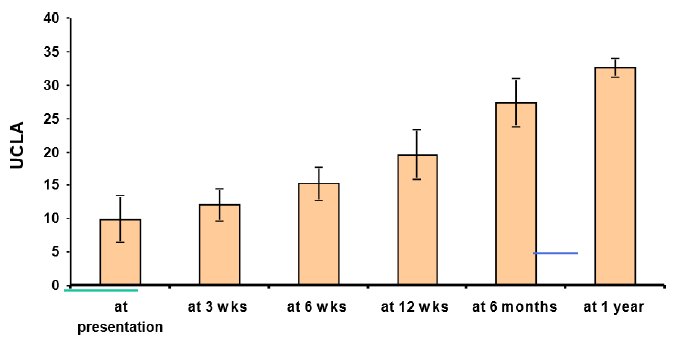
|
Difference |
Ucla at presentation -At 3 wks |
Ucla at presentation – at 6 wks |
Ucla at presentation - at 12 wks |
Ucla at presentation - at 6 months |
Ucla at presentation - at 1 year |
||
|
Mean ±sd |
-2.14±2.34 |
-5.38±0.96 |
-9.73±4.88 |
-17.53±4.95 |
-22.84±3.82 |
||
|
P value |
<0.001** |
<0.001** |
<0.001** |
<0.001** |
<0.001** |
||
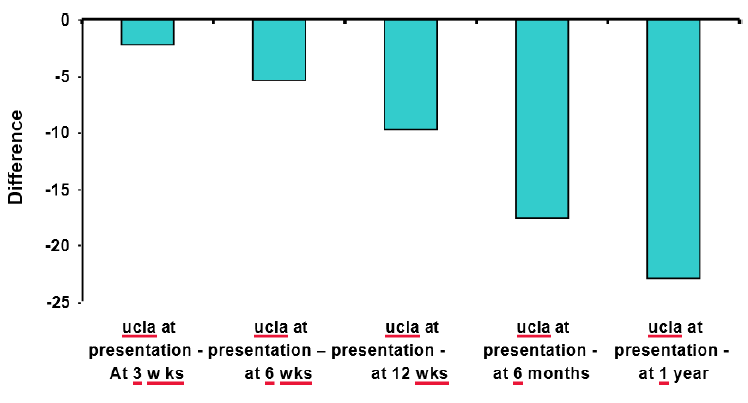
Difference of Ulca and pair wise significance.
|
Ulca |
Type of tear |
P value |
|
|
Full thickness |
Partial |
||
|
At presentation |
10.00±4.24 |
9.88±3.05 |
0.930 |
|
At 3 weeks |
11.91±2.39 |
12.19±2.51 |
0.775 |
|
At 6 weeks |
15.40±3.13 |
15.06±2.08 |
0.743 |
|
At 12 weeks |
18.90±3.28 |
19.94±4.06 |
0.503 |
|
At 6 wonths |
27.00±3.94 |
27.56±3.58 |
0.711 |
|
At 1 year |
33.10±1.66 |
32.38±1.20 |
0.209 |
No significance difference noted based on full thickness and partial rotator cuff tear.
Comparison of Ulca score according to type of tear.
|
Vas Pain Score |
||||
|
At presentation |
At 3 wks |
At 6 wks |
At 6 months |
|
|
Min-Max |
6-9 |
4-6 |
2-5 |
2-4 |
|
Mean ±sd |
7.575±0.843 |
4.775±0.891 |
3.6±0.744 |
2.35±0.662 |
Evaluation of Vas score (Visual Analog Score).
There is significant decrease in the visual analog pain score pre and post injection of platelet rich plasma followed between 3 weeks, 6 weeks, and 6 months.
Case 1
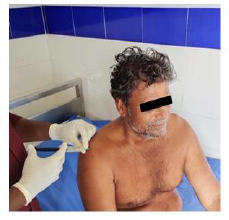
Patient during Platelet Rich Plasma injection- Right shoulder for Partial thickness Rotator cuff tear (Supraspinatus tear).
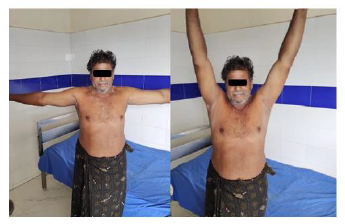
Range of movements at 6 months follow up post injection.
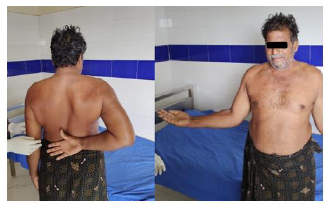
4. Discussion
Rotator cuff disease encompasses a wide range of pathology from minimal bursal or articular side irritation and tendonitis to severe degenerative rotator cuff arththropathy. Rotator cuff pathology affects adults of all ages and other shoulder afflictions must be ruled out by careful history and physical examination [1]. Epidemiological studies strongly support a relationship between age and cuff tears prevalence. The use of biological agents, including Prp and mesenchymal stem cells (Mscs) in orthopedics, has increased exponentially over the last few years due to its autologous nature, lack of side-effects, and supposed effectiveness.
Platelet-rich plasma is an autologous blood product with platelet concentrations above baseline. The preparation process involves the extraction of 34 ml of blood from the patient with the help of a scalp vein set, and after adding anticoagulant (Acda) centrifuged to obtain a concentrated suspension of platelets by plasmapheresis which then undergoes a two-stage centrifugation process to separate the solid and liquid components of the blood. The initial phase separates plasma and platelets from the erythrocytes and leucocytes. The second hard spin to concentrate the platelets further into platelet-rich and platelet-poor plasma components. The final platelet-rich product is then injected into the knee joint space. There is also debate on the potential benefits of platelet-poor plasma on healing, and some formulations do not incorporate this step.
As well as platelets, Prp contains white blood cells and some proteins. Tissue repair is a complex process comprising chemotaxis, angiogenesis, cell proliferation, and matrix formation. Platelets are involved in all of these functions by the release of growth factors. High concentrations of proteins such as platelet-derived growth factor (Pdgf), vascular endothelial growth factor (Vegf), endothelial cell growth factor, and the fibroblast growth factor have led to suggestions that Prp may be useful in conditions requiring tissue healing. Conversely, the other protein in Prp, transforming growth factor (Tg)F-Β1, has an inhibitory effect and can lead to non-predictable results.
5. General Observations
- Majority of patients were between age 51-60 years who had difficulty in carrying out their activities of daily living.
- Age distribution revealed a mean age in to be 65.
- Gender distributions were comparable in both groups, with 65 % being male 35% being
- Thus the study of platelet-rich plasma ensured that all patients were comparable to
- Majority of them were men forming 64.3 % whereas the rest of them were women forming 7%.
- The ucla score showed a mean of 325 at the pre-injection period, which increased to 27.32 and 32.7 at 6 weeks and 1year follow up respectively.
- The study showed a significant increase in the ucla score, which was also consistent throughout the study period.
- Majority of patients the etiology was Degenerative tear about 80%.
- Majority of patients complained of inability to lift the shoulder following
- The incidence of partial thickness tears was 22 out of 40 evaluated and full thickness tears noted in rest
- Bilateral rotator cuff tears was noted in one
- The visual analog score showed a decrease in mean of 575 to 2.35, which denotes a change of patient‘s perception of pain from intense, dreadful, horrible pain to mild annoying pain.
6. Conclusion
Our study of platelet-rich plasma relied on injecting a highly concentrated mix of platelets into the shoulder and observing the patients for the decrease in symptoms of pain, and improvement in physical function .our study has revealed a consistent reduction in pain and a definite improvement in lifestyle of the patients. Our study of platelet-rich plasma has thrown up an exciting choice of treatment modality using platelet rich plasma in the treatment of rotator cuff tears, and it has proved efficient in the observation period of one year.
7. Summary
A prospective study was done in NRI Institute of Sciences which included patients who were treated with platelet rich plasma for rotator cuff tear from 2018 t0 2020 . Patients were followed up at 3 weeks 6 weeks 12 weeks, 6 months and at 1 year. The patient was evaluated at presentation and at follow up. At follow up patient is asked to fill proforma and functional outcome was assessed using vas and Ucla shoulder scoring system. The study showed that there was significant improvement in pain, strength, patient satisfaction, range of motion and ability to carry activities of daily living irrespective of type of tear and technique used when strict post-operative physiotherapy is followed. Further there is no hospital stay and can be done in outpatient department and patient can return early to their activities. A study with larger sample size, with more number of cases in each group to make definite recommendations.
References
- Via AG, decupis MD, Spoliti M, et al. Clinical and biological aspects of rotator cuff tears. Muscles Ligaments and Tendons Journal 3 (2013): 70-79.
- Sadoghi P, Lohberger B Aigner, et al. Effects of platelet-rich plasma on the biologic activity of the human rotator-cuff fibroblasts: A controlled in vitro study. Journal of Orthopedic Research (2013): 1249-1253
- Della-Giustina D, Harrison B. Shoulder Pain. In Tintinalli JE, Stapczynski J, Ma O, et al. T(Eds), Tintinallis Emergency Medicine: A Comprehensive studyguide (2011): 7e.
- Milgrom C, Schaffler M, Gilbert S, et al. Rotator cuff changes in asymptomatic adults. The effect of age, hand dominance, and gender. J Bone Joint Surg Br 77 (1995): 296-298.
- Jost B, Zumstein M, Pfirrmann CW, et al. Long-term outcome after structural failure of rotator cuff repairs. JBJS 88 (2006): 472-479.
- Mautner K, Colberg RE, Malanga G, et al. Outcomes after ultrasound-guided platelet-rich plasma injections for chronic tendinopathy: A multicenter, retrospective review. PM and R 5 (2013): 169-175.
- Longo UG, Franceschi F, Berton A, et al. Conservative treatment and rotator cuff tear progression. Med Sport Sci 57 (2012): 90-99.


 Impact Factor: * 5.3
Impact Factor: * 5.3 Acceptance Rate: 73.64%
Acceptance Rate: 73.64%  Time to first decision: 10.4 days
Time to first decision: 10.4 days  Time from article received to acceptance: 2-3 weeks
Time from article received to acceptance: 2-3 weeks 